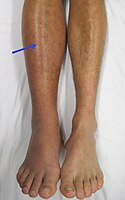
Photo from wikipedia
Two of the more common potential complications after arthroplasty are venous thromboembolism (VTE), which includes deep vein thrombosis (DVT) and pulmonary embolus (PE), and excess bleeding. Appropriate chemoprophylaxis choices are… Click to show full abstract
Two of the more common potential complications after arthroplasty are venous thromboembolism (VTE), which includes deep vein thrombosis (DVT) and pulmonary embolus (PE), and excess bleeding. Appropriate chemoprophylaxis choices are essential to prevent some of these adverse events and from exacerbating others. Risk stratification to prescribe safe and effective medications in the prevention of postoperative VTE has shown benefit in this regard. The Department of Orthopaedic Surgery at Syosset Hospital/Northwell Health, which performs over 1200 arthroplasties annually, has validated and is using the 2013 version of the Caprini Risk Assessment Model (RAM) to stratify each patient for risk of postoperative VTE. This tool results in a culling of information, past and present, personal and familial, that provides a truly thorough evaluation of the patient’s risk for postoperative VTE. The Caprini score then guides the medication choices for thromboprophylaxis. The Caprini score is only valuable if the data is properly collected, and we have learned numerous lessons after applying it for 18 months. Risk stratification requires practice and experience to achieve expertise in perioperative patient evaluation. Having access to pertinent patient information, while gaining proficiency in completing the Caprini RAM, is vital to its efficacy. Ongoing, real time analyses of patient outcomes, with subsequent change in process, is key to improving patient care.
Journal Title: Clinical and Applied Thrombosis/Hemostasis
Year Published: 2020
Link to full text (if available)
Share on Social Media: Sign Up to like & get
recommendations!